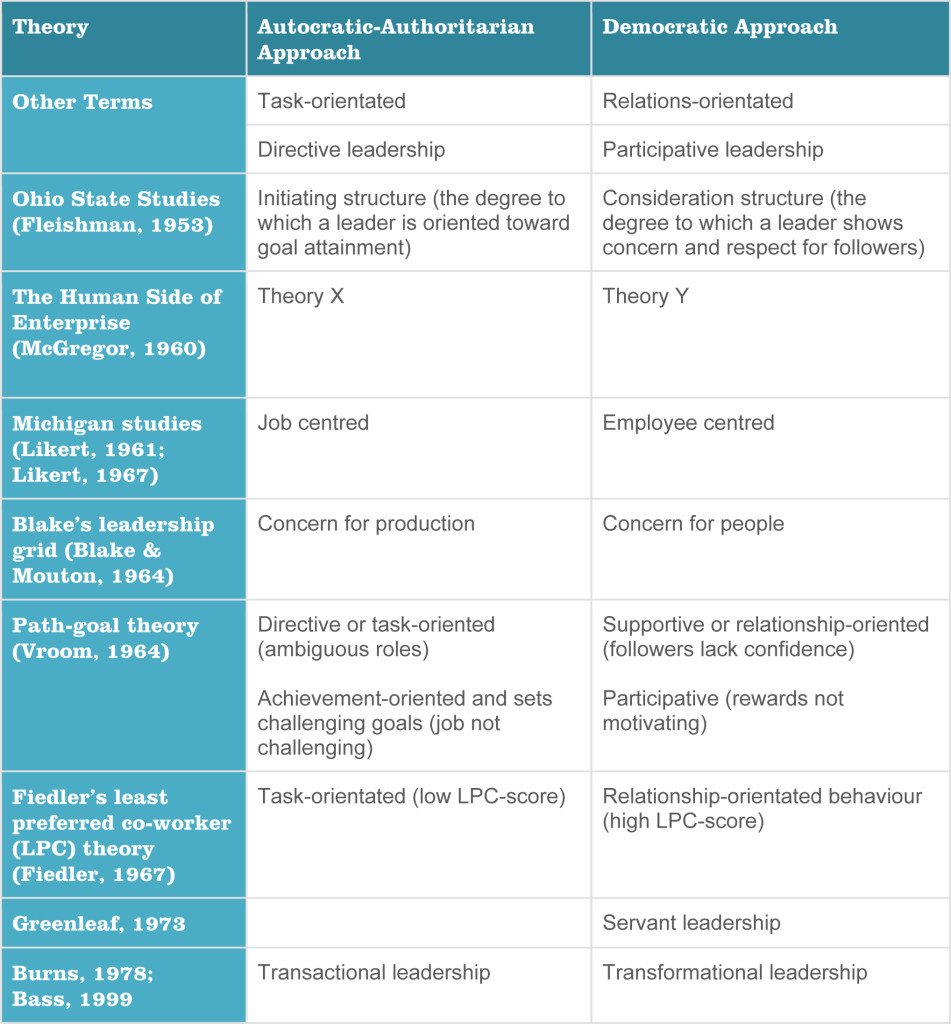Autocratic versus Democratic leadership: Are you the right tool for the right job?

‘When all you have is a hammer, everything looks like a nail’, as the Maslow quote goes. The best leadership is said to be situational, with effective leaders changing their approach to accommodate their situation. This can become a challenge when the situation changes rapidly or when the leader is capable of only one approach.
The continuum
Leadership style is often presented as an either/or proposition with regards to how leaders deal with people. “Autocratic” and “democratic” are terms used to define end points of a continuum developed over the years by those who study such things, as outlined in the table below:

According to Bernard Bass, an author and researcher of all things leadership, the autocratic leader tends to:
- be arbitrary, controlling, power-orientated, coercive, punitive, and close-minded;
- foster in subordinates greater resentment, less loyalty, less commitment, less involvement, and less satisfaction;
- take full and sole responsibility for decisions and control of followers’ performance;
- stress obedience, loyalty, and strict adherence to the rules; and
- make and enforce the rules and see that decisions are carried out.
Democratic leaders on the other hand demonstrate the following attributes:
- leadership is considerate, consultative, participative, consensual, employee-centered, concerned with people, concerned with the maintenance of good working relations, supportive and orientated toward facilitating interaction, and relations-orientated;
- a belief that workers are internally motivated to do well and seek autonomy and the opportunity to prove their worth; and
- move decision-making to lower levels, encourage questioning and ideas, open to criticism, treat subordinates’ mistakes as learning opportunities, celebrate subordinates’ accomplishments, promote subordinates’ ideas to higher authority.
So which is better according to research? It depends.
At face value, the democratic approach is often considered “better”. While the autocratic approach is best applied when organisations need to be turned around quickly, it is also most frequently associated with workers quitting their jobs. Autocratic leadership tends to be more punitive and the inherent close supervision increases role ambiguity, reduces productivity, and decreases group harmony.
The democratic approach on the other hand works best when it is visibly supported by higher authority, members are well-educated, leaders have the skills to conduct meetings with the members, and time can be afforded for trust to develop. If these factors exist, then the democratic approach results in higher rates of productivity, reduced personnel turnover, reduced absenteeism, and better employee physical and mental health.
Which approach is appropriate depends in part on the nature of the follower and the environment. Democratic leadership is desirable in situations where the workforce becomes educated and seeks greater participation, when business becomes more complex, and when the use of advanced technology increases and there is greater emphasis on team expertise. Immature, dependent, and inexperienced subordinates are more likely to expect and accept authoritarian direction, whereas a democratic approach results in more rapid employee development.
We are often presented with a value judgement of autocratic leadership as bad and democratic leadership as good. This is not always the case. Authoritarian leadership works best with authoritarian followers in an authoritarian culture. There are times when an authoritarian approach is appropriate, as the leader of a high performing group can afford to be more democratic than the leader of a poor performing group.
The right tool for the right job
I question how much a leader can operate outside of their preferred method, and to what extent a new leader is necessary when the situation changes. I also question the extent that the leader creates situations that best suits their approach. Taking an autocratic approach can become a self-fulfilling prophesy, creating crisis situations that justify an autocratic leader’s preferred method.
A strict collaborative democratic approach is not always the answer either. Approaches such as Greenleaf’s servant leadership can result in positive customer and client satisfaction but is not necessarily correlated with positive profit outcomes. Practical application can be seen as unrealistic, encouraging passivity, and not being appropriate for all situations or serving the wrong cause.
A balance is needed and there are times to operate in either mode, but leadership should always begin with a regard for the individual within the organisational objectives and alignment with the leader’s core values. Leadership studies identify that great leaders derive pleasure from developing the innate potential of others and operate with an integrity and authenticity that comes from being true to themselves. The success of the approach depends not only on the situation but also on the alignment within the leader. As Bass states:
“the degree that leaders are consistent in what they think they ought to do, they will have a consistent style of leadership.”
This aligns with an axiom I have found true in most organisations: “As the head is, so the body shall be.”
We hear more about democratic leadership during times of low unemployment. As economic conditions tighten, more autocratic leadership approaches emerge as leaders default to a path of least resistance to achieving short-term reactionary outcomes. These pressures push out conversations about motivation theories and the creation of firms of endearment, overridden by seeming realities of profitability and cash flow.
Autocratic leaders create top-down, command-and control-situations best suited for their leadership style. Democratic leaders create collaborative, people-focused environments aligned with their mode of operation. Removing moral judgement from the discussion, each approach can create the appropriate situation for the leader, provide organisational results, and attract or retain people who align or can adapt to the leader’s approach.
What kind of leader do you think you are and what kind of leader would your followers say you are? Can you and do you change to accommodate your situation? If you are feeling democratic, feel free to collaborate with me in the comments below. If you are overly autocratic, tell me how it is and leave it at that.

I find “autocratic” next to impossible for me. Good observations!
Incidentally, the term “democratic” seems to be a dreadful misnomer. Rarely would collaborative leaders actually engage in something as crass as voting. It would almost certainly undermine confidence.
Also, I found it fascinating to work recently in an environment completely managed by concensus. It struck me then, that my “collaborative” management style was neither autocratic nor democratic, but neither had it been truly collegiate. I started to see how to express real leadership in that environment, and the appeal of it.
Of course, your caveats about right-tool-for-the-job apply.
Thanks Kevin! Yes, “democratic” can be an awkward foil to autocratic. I see them both as just a container to package up a preferred ethos and approach to leading others. As the table shows, many researchers have tried other words to infer the same distinction.
Glad to hear of your practical experience. Knowing what you do on your weekends, you have a significant leadership opportunity / challenge that requires a very specialised skill set, one very much aligned with the collaborative approach.
The above research about leadership is good enough however there hardly any referencing to make it more academic. is there?
Hi B.B.
Ask and you shall receive. 🙂
Most can be found in Bass, but a few other originals included below:
Bass, B. M. (2008). The Bass Handbook of Leadership: Theory, Research & Managerial Applications, 4th ed. Free Press, New York, NY.
Fleishman, E.A. (1953). The description of supervisory behavior. Personnel Psychology, 37, 1-6
McGregor, D. (1960). The Human Side of Enterprise. New York, McGrawHill
Blake, R. R. & Mouton, J. S. (1964). The Managerial Grid. Gulf Publishing, Houston Texas
Likert, R. (1961). New Patterns of Management. McGraw-Hill, New York.
Likert, R. (1967). The Human Organization. McGraw-Hill, New York
Greenleaf, R. K. (1973). The Servant as Leader, Cambridge, MA: Center for Applied Studies
Chad
Hi ,
I believe I am Democratic. How do the two work together when the other doesn’t realize their style is autocratic or care?